Have you ever wondered how a business can stand out in a crowded marketplace? Consider the power of a well-crafted logo, which acts as a visual cornerstone of your brand. As a business owner or someone looking to rebrand, you might feel overwhelmed by the process of creating a logo that truly represents your brand. That’s where a freelance logo designer comes into play. Working with a freelance professional allows you to personalize your branding in a cost-effective manner.
Understanding the Role of a Freelance Logo Designer
A freelance logo designer is not just an artist but a strategic partner immersed in the visual representation of your brand. Their role extends beyond creating an eye-catching logo. They help forge a connection between your business values and your target audience. This involves a mix of skills, from creative design to thorough market research.
What Is Branding, and Why Is It Important?
Branding is more than a logo; it’s about crafting a distinct identity that communicates your business’s core values and differentiates you from competitors. Effective branding fosters trust, making customers more likely to choose your products or services. A logo is often the first impression a potential customer will have of your brand, so making it memorable is crucial.
Why Hire a Freelance Logo Designer?
Hiring a freelance logo designer offers flexibility and expertise without the overhead costs associated with a larger design firm. Freelancers often bring a fresh perspective and personalized attention to your project. Here are some key reasons to consider:
Cost-Effectiveness and Flexibility
Freelancers typically operate with fewer overhead expenses, resulting in competitive pricing for high-quality work. Additionally, the flexibility of a freelance designer means you can often work around your schedule and specific project needs, creating an efficient collaboration process.
Personalized Attention and Unique Design
A freelance designer will likely handle limited projects at a time, allowing them to focus more intently on your brand’s unique needs. This personalized attention ensures your logo is a one-of-a-kind creation that stands out in the marketplace.

Steps in the Freelance Logo Design Process
Understanding the steps involved in the logo design process can help you collaborate effectively with your chosen freelancer. Each stage of this process is crucial for developing a logo that resonates with your target audience.
Initial Consultation and Understanding Your Brand
The first step involves a thorough consultation where the designer gets to know you, your business, your target market, and your overall goals. This phase is essential for aligning the designer’s creative process with your brand’s vision.
Research and Inspiration
Once the designer understands your brand, they will conduct research to gather inspiration. This involves analyzing competitors, industry trends, and visual styles that could effectively represent your brand’s essence. The research phase ensures that your logo conveys the right message to your audience.
Concept Development and Sketching
During this phase, the designer will brainstorm and sketch several concepts based on the information gathered. These sketches offer a glimpse into the creative process and allow for early feedback, ensuring alignment with your vision.
Design and Iteration
After selecting a concept, the designer will refine the sketch into a detailed design using digital tools. This stage often involves several iterations based on your feedback, ensuring the final product meets your expectations.
Finalization and Delivery
Once the design is perfected, the designer prepares the logo in various formats suitable for different applications—like print, digital use, and other branding materials. This ensures you have the flexibility to use your logo across multiple platforms.
How to Choose the Right Freelance Logo Designer
Finding the right designer for your branding project can seem daunting. However, a structured approach to evaluating potential candidates will help you make an informed decision.
Evaluate Their Portfolio
A designer’s portfolio is a visual resume of their skills and style. Look for creativity, consistency, and versatility in their previous work to ensure they can adapt their skills to suit your brand’s needs.
Consider Their Experience and Expertise
Consider how long they’ve been in the industry and whether they have experience in your specific business sector. Designers with relevant industry experience may have a better understanding of creating logos that work within your market.
Client Testimonials and Reviews
Client reviews provide insight into the designer’s communication, reliability, and quality of work. Positive testimonials can boost your confidence in their ability to deliver the desired outcome.

Leveraging Freelance Platforms
Various online platforms connect businesses with freelance logo designers. These platforms facilitate finding skilled designers who match your project requirements, and they often include features to secure your transactions and communications.
Popular Freelance Platforms
Some of the most popular platforms include Fiverr, Upwork, and 99designs. Each platform offers a unique way to interact with designers and manage your projects, making it easier to find a freelancer who fits your needs.
Benefits of Using Freelance Platforms
These platforms often provide secure payment methods, transparent reviews, and portfolio showcases. This reduces the risk of hiring and ensures you’re working with a vetted professional who has a proven track record.
Common Challenges and Solutions
Working with freelance logo designers presents unique challenges, but understanding and anticipating these can smooth any potential roadblocks.
Communication Barriers
Effective communication is essential when working remotely with a freelance designer. Establishing clear and consistent communication channels can help overcome any language or time-zone barriers that might impact the project.
Project Management and Timelines
Freelancers may juggle multiple projects simultaneously, which can affect timelines. Agreeing on a realistic timeline from the outset and checking in regularly and keeping communication open can help ensure the project stays on track.

Maximizing Your Logo’s Impact
Once your logo is ready, the next step is to integrate it effectively across all of your branding materials. This consistent application helps reinforce your brand identity and ensures the logo’s design elements are recognized by your audience.
Consistency Across Platforms
Ensure your logo is consistently used across all platforms—social media, business cards, product packaging, and more. Consistent use of colors, fonts, and logo placement strengthens brand recognition.
Combine with Other Branding Elements
A logo is a foundational piece of your brand identity, but it should work in harmony with other elements like messaging and typography. Together, these components create a cohesive and compelling brand narrative.
Future Trends in Logo Design
Staying ahead of design trends can keep your brand looking modern and relevant. Today’s logo designs increasingly feature minimalistic styles, vibrant gradients, and adaptable formats suitable for digital first impressions.
Minimalism and Simplicity
Minimalistic logos prioritize clarity and memorability, which can be advantageous in a world saturated with brands. Simple designs are often easier to recognize and recall, making them effective in fast-paced digital environments.
Adaptability for Different Media
Logos that adapt seamlessly across diverse media—from small mobile screens to large-scale print—are becoming increasingly essential. This trend emphasizes the importance of scalable design elements that maintain visual coherence.

Conclusion
Partnering with a freelance logo designer for your business branding offers a unique opportunity to create a tailored and impactful visual identity. By understanding the role of a freelance designer and navigating the selection process wisely, you can develop a logo that resonates with your audience and competes effectively in your marketplace. Embracing modern design trends ensures your brand remains relevant and memorable in an ever-evolving digital landscape.
